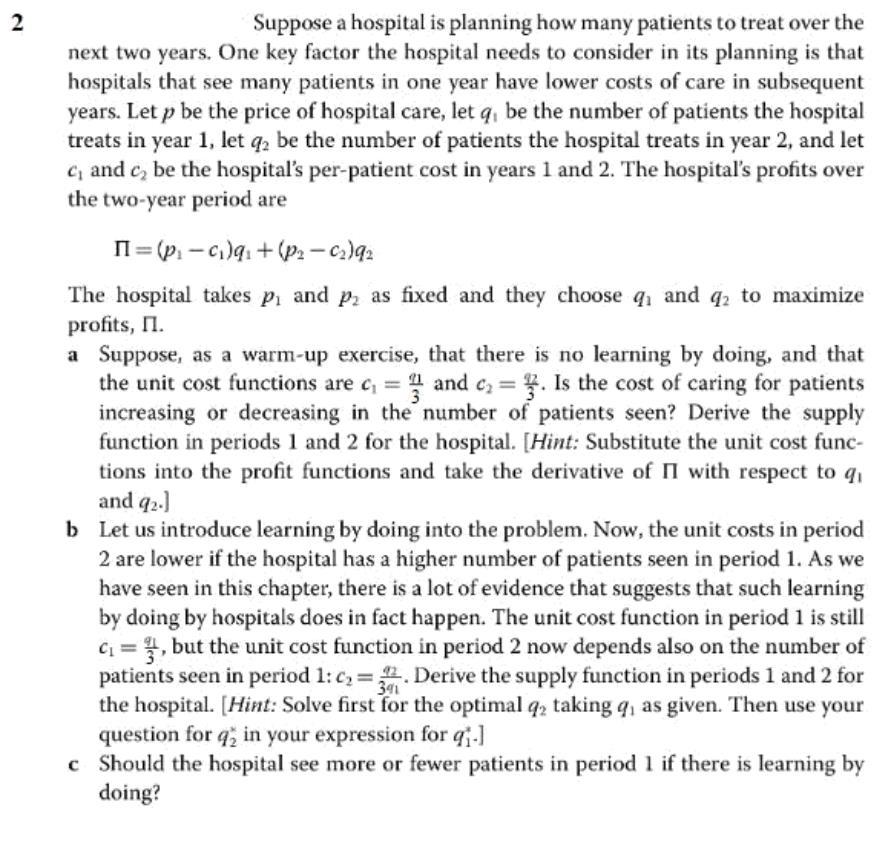
Suppose a hospital is planning how many patients to treat over the next two years. One key factor the hospital needs to consider in its planning is that hospitals that see many patients in one year have lower costs of care in subsequent years. Let p be the price of hospital care, let q1 be the number of patients the hospital treats in year 1 , let q2 be the number of patients the hospital treats in year 2 , and let c1 and c2 be the hospital's per-patient cost in years 1 and 2 . The hospital's profits over the two-year period are =(p1c1)q1+(p2c2)q2 The hospital takes p1 and p2 as fixed and they choose q1 and q2 to maximize profits, . a Suppose, as a warm-up exercise, that there is no learning by doing, and that the unit cost functions are c1=31 and c2=312. Is the cost of caring for patients increasing or decreasing in the number of patients seen? Derive the supply function in periods 1 and 2 for the hospital. [Hint: Substitute the unit cost functions into the profit functions and take the derivative of with respect to q1 and q2.] b Let us introduce learning by doing into the problem. Now, the unit costs in period 2 are lower if the hospital has a higher number of patients seen in period 1 . As we have seen in this chapter, there is a lot of evidence that suggests that such learning by doing by hospitals does in fact happen. The unit cost function in period 1 is still c1=3q1, but the unit cost function in period 2 now depends also on the number of patients seen in period 1:c2=3q1q2. Derive the supply function in periods 1 and 2 for the hospital. [Hint: Solve first for the optimal q2 taking q1 as given. Then use your question for q2 in your expression for q1.] c Should the hospital see more or fewer patients in period 1 if there is learning by doing? Suppose a hospital is planning how many patients to treat over the next two years. One key factor the hospital needs to consider in its planning is that hospitals that see many patients in one year have lower costs of care in subsequent years. Let p be the price of hospital care, let q1 be the number of patients the hospital treats in year 1 , let q2 be the number of patients the hospital treats in year 2 , and let c1 and c2 be the hospital's per-patient cost in years 1 and 2 . The hospital's profits over the two-year period are =(p1c1)q1+(p2c2)q2 The hospital takes p1 and p2 as fixed and they choose q1 and q2 to maximize profits, . a Suppose, as a warm-up exercise, that there is no learning by doing, and that the unit cost functions are c1=31 and c2=312. Is the cost of caring for patients increasing or decreasing in the number of patients seen? Derive the supply function in periods 1 and 2 for the hospital. [Hint: Substitute the unit cost functions into the profit functions and take the derivative of with respect to q1 and q2.] b Let us introduce learning by doing into the problem. Now, the unit costs in period 2 are lower if the hospital has a higher number of patients seen in period 1 . As we have seen in this chapter, there is a lot of evidence that suggests that such learning by doing by hospitals does in fact happen. The unit cost function in period 1 is still c1=3q1, but the unit cost function in period 2 now depends also on the number of patients seen in period 1:c2=3q1q2. Derive the supply function in periods 1 and 2 for the hospital. [Hint: Solve first for the optimal q2 taking q1 as given. Then use your question for q2 in your expression for q1.] c Should the hospital see more or fewer patients in period 1 if there is learning by doing







